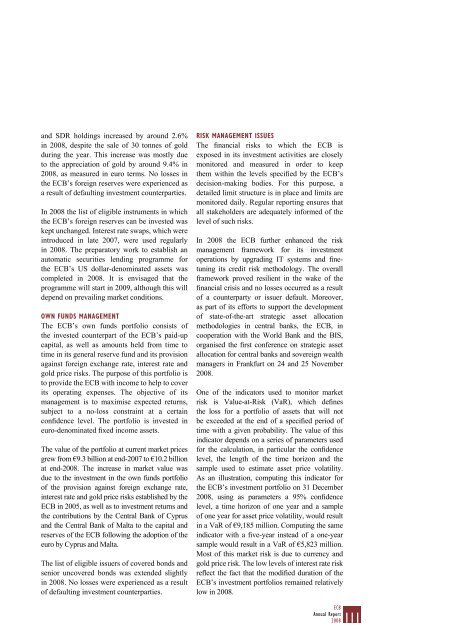ANNUAL REPORT 2008 - Polymer Bank Notes of the World
ANNUAL REPORT 2008 - Polymer Bank Notes of the World
ANNUAL REPORT 2008 - Polymer Bank Notes of the World
You also want an ePaper? Increase the reach of your titles
YUMPU automatically turns print PDFs into web optimized ePapers that Google loves.
and SDR holdings increased by around 2.6%in <strong>2008</strong>, despite <strong>the</strong> sale <strong>of</strong> 30 tonnes <strong>of</strong> goldduring <strong>the</strong> year. This increase was mostly dueto <strong>the</strong> appreciation <strong>of</strong> gold by around 9.4% in<strong>2008</strong>, as measured in euro terms. No losses in<strong>the</strong> ECB’s foreign reserves were experienced asa result <strong>of</strong> defaulting investment counterparties.In <strong>2008</strong> <strong>the</strong> list <strong>of</strong> eligible instruments in which<strong>the</strong> ECB’s foreign reserves can be invested waskept unchanged. Interest rate swaps, which wereintroduced in late 2007, were used regularlyin <strong>2008</strong>. The preparatory work to establish anautomatic securities lending programme for<strong>the</strong> ECB’s US dollar-denominated assets wascompleted in <strong>2008</strong>. It is envisaged that <strong>the</strong>programme will start in 2009, although this willdepend on prevailing market conditions.OWN FUNDS MANAGEMENTThe ECB’s own funds portfolio consists <strong>of</strong><strong>the</strong> invested counterpart <strong>of</strong> <strong>the</strong> ECB’s paid-upcapital, as well as amounts held from time totime in its general reserve fund and its provisionagainst foreign exchange rate, interest rate andgold price risks. The purpose <strong>of</strong> this portfolio isto provide <strong>the</strong> ECB with income to help to coverits operating expenses. The objective <strong>of</strong> itsmanagement is to maximise expected returns,subject to a no-loss constraint at a certainconfidence level. The portfolio is invested ineuro-denominated fixed income assets.The value <strong>of</strong> <strong>the</strong> portfolio at current market pricesgrew from €9.3 billion at end-2007 to €10.2 billionat end-<strong>2008</strong>. The increase in market value wasdue to <strong>the</strong> investment in <strong>the</strong> own funds portfolio<strong>of</strong> <strong>the</strong> provision against foreign exchange rate,interest rate and gold price risks established by <strong>the</strong>ECB in 2005, as well as to investment returns and<strong>the</strong> contributions by <strong>the</strong> Central <strong>Bank</strong> <strong>of</strong> Cyprusand <strong>the</strong> Central <strong>Bank</strong> <strong>of</strong> Malta to <strong>the</strong> capital andreserves <strong>of</strong> <strong>the</strong> ECB following <strong>the</strong> adoption <strong>of</strong> <strong>the</strong>euro by Cyprus and Malta.The list <strong>of</strong> eligible issuers <strong>of</strong> covered bonds andsenior uncovered bonds was extended slightlyin <strong>2008</strong>. No losses were experienced as a result<strong>of</strong> defaulting investment counterparties.RISK MANAGEMENT ISSUESThe financial risks to which <strong>the</strong> ECB isexposed in its investment activities are closelymonitored and measured in order to keep<strong>the</strong>m within <strong>the</strong> levels specified by <strong>the</strong> ECB’sdecision-making bodies. For this purpose, adetailed limit structure is in place and limits aremonitored daily. Regular reporting ensures thatall stakeholders are adequately informed <strong>of</strong> <strong>the</strong>level <strong>of</strong> such risks.In <strong>2008</strong> <strong>the</strong> ECB fur<strong>the</strong>r enhanced <strong>the</strong> riskmanagement framework for its investmentoperations by upgrading IT systems and finetuningits credit risk methodology. The overallframework proved resilient in <strong>the</strong> wake <strong>of</strong> <strong>the</strong>financial crisis and no losses occurred as a result<strong>of</strong> a counterparty or issuer default. Moreover,as part <strong>of</strong> its efforts to support <strong>the</strong> development<strong>of</strong> state-<strong>of</strong>-<strong>the</strong>-art strategic asset allocationmethodologies in central banks, <strong>the</strong> ECB, incooperation with <strong>the</strong> <strong>World</strong> <strong>Bank</strong> and <strong>the</strong> BIS,organised <strong>the</strong> first conference on strategic assetallocation for central banks and sovereign wealthmanagers in Frankfurt on 24 and 25 November<strong>2008</strong>.One <strong>of</strong> <strong>the</strong> indicators used to monitor marketrisk is Value-at-Risk (VaR), which defines<strong>the</strong> loss for a portfolio <strong>of</strong> assets that will notbe exceeded at <strong>the</strong> end <strong>of</strong> a specified period <strong>of</strong>time with a given probability. The value <strong>of</strong> thisindicator depends on a series <strong>of</strong> parameters usedfor <strong>the</strong> calculation, in particular <strong>the</strong> confidencelevel, <strong>the</strong> length <strong>of</strong> <strong>the</strong> time horizon and <strong>the</strong>sample used to estimate asset price volatility.As an illustration, computing this indicator for<strong>the</strong> ECB’s investment portfolio on 31 December<strong>2008</strong>, using as parameters a 95% confidencelevel, a time horizon <strong>of</strong> one year and a sample<strong>of</strong> one year for asset price volatility, would resultin a VaR <strong>of</strong> €9,185 million. Computing <strong>the</strong> sameindicator with a five-year instead <strong>of</strong> a one-yearsample would result in a VaR <strong>of</strong> €5,823 million.Most <strong>of</strong> this market risk is due to currency andgold price risk. The low levels <strong>of</strong> interest rate riskreflect <strong>the</strong> fact that <strong>the</strong> modified duration <strong>of</strong> <strong>the</strong>ECB’s investment portfolios remained relativelylow in <strong>2008</strong>.ECBAnnual Report<strong>2008</strong>111




![KNOW YOUR NEW GIBRALTAR BANKNOTES - [Home] bThe/b](https://img.yumpu.com/50890985/1/184x260/know-your-new-gibraltar-banknotes-home-bthe-b.jpg?quality=85)
![PAPUA NEW GUINEA - [Home] - Polymer Bank Notes of the World](https://img.yumpu.com/49758743/1/190x143/papua-new-guinea-home-polymer-bank-notes-of-the-world.jpg?quality=85)










